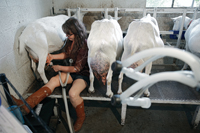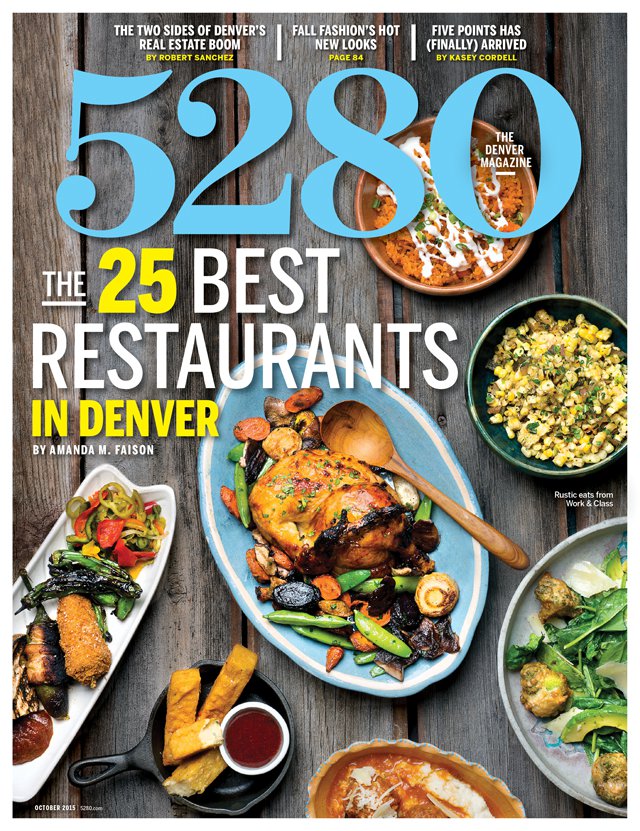The Local newsletter is your free, daily guide to life in Colorado. For locals, by locals.
Step into the pen at Broken Shovels Farm in Henderson and you’ll learn the first lesson of goat husbandry: It’s not easy to tell the furry head-butters what to do. But as Andrea Davis, owner of the farm and de facto pack leader, wades through her flock of 75, dispensing pats and ear scratches, it’s clear that she’s mastered the art of caring for the mischievous creatures. In fact, Davis runs one of the few commercial, slaughter-free goat dairies in the country. She never harvests mature or young goats for their meat, nor does she separate her does from their kids—both common practices at dairy farms. When a Broken Shovels goat ages out of her milking years, Davis literally puts her out to pasture, where the goat eats oats and basks in the sunshine until her final days. These, you could say, are happy goats. And, happy goats make good cheese. Broken Shovels’ cheeses—a smooth yogurt version, tubs of chèvre, a flavorful ricotta, and the harder, tangy Dark Moon—are highly sought after. They can be found at many top Denver restaurants, including Root Down and the Populist, and at specialty stores, such as St. Kilian’s Cheese Shop. But despite her tireless work ethic (she sometimes toils up to 20 hours a day), Davis says the weekly market demand for her products is sometimes twice the amount she’s able to produce. Here, a peek inside her daily schedule.
 5:30 a.m. Davis wakes up and heads to the basement, where she keeps the cheese-making equipment. Here, she tends to the cheese. Each type goes through a different treatment but follows roughly the same timeline: It takes less than a week from milking to final product.
5:30 a.m. Davis wakes up and heads to the basement, where she keeps the cheese-making equipment. Here, she tends to the cheese. Each type goes through a different treatment but follows roughly the same timeline: It takes less than a week from milking to final product.
6:30 a.m. Davis checks on her goats and hand-mixes feed for their morning meal. Broken Shovels’ goats get a combination of barley, molasses, sunflower seeds, flax, bran, kelp, oats, and field peas. Every ingredient is human-grade—good enough for Davis, or her customers, to eat.

7 a.m. The first round of milking begins. As goats are herded into the milking room, they walk onto a metal grate where, once positioned correctly, their necks are secured with a sliding lock mechanism. The girls eat their morning meals as Davis milks them; if it weren’t for the locking mechanisms, more dominant animals (like aptly named six-year-old Diva) would graze in their neighbors’ troughs in addition to their own.
10 a.m. The goats are let out into the yard to do as they please. Then the farmyard work begins: It’s a Sisyphean job cleaning up after the animals, but Davis scoops, sweeps, and lays new straw as needed.

Noon Davis eats lunch and tackles administrative work and cheese tasks. Milk from that morning goes into her 22-gallon pasteurizer (one gallon of milk weighs about nine pounds and will produce one to two pounds of cheese), where it’s sterilized for 30 minutes at 145 degrees Fahrenheit. Afterward, Davis inoculates the milk with a bacterial culture. The particular kind of bacteria she uses will determine the type of cheese as well as its texture and flavor profile. Then comes the rennet—a yellow-brown vegetable-derived coagulant that allows the cheese to solidify as the bacterial culture grows.
1:30 p.m. Nap time. Because of the demanding hours of her job, Davis says she’s tried all of the productivity-based “sleep hacks” she’s come across. Ultimately, Davis has found she works best when she sleeps in two shifts: five-and-a-half hours at night and two around midday.
3:30 p.m. Afternoon chores begin, including cleanup, hay distributing, and hoof-trimming. As Davis goes about the farmyard, a small cluster of goats is always close behind.

5:30 p.m. It’s time for the second milking and the goats’ second full meal. The evening milking goes much like the morning milking and takes about the same amount of time.
9:30 p.m. Davis pauses for dinner. Afterward, the coagulating cultured milk in the pasteurizer is taken through the next stages. For the Dark Moon cheese—Davis’ signature product—milk is inoculated with cultures, ripened in a vat, and drained in cheesecloth. The remaining curds are formed into flat rounds that are then stamped, salted, and dusted with ash. (Old World cheese-makers used alkaline ash to control acidity. Davis uses applewood ash made from a tree on her property.) Finally, the cheese is aged in “the cave,” a cold, dry closet kept at a constant 55 degrees. Here, it will grow a fluffy white rind.
Midnight Davis turns in for the night.









